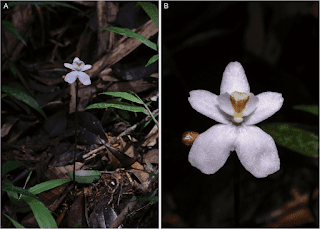Since plants are corporeal beings, there is nothing inherently ghostly about them in reality. These plants gain the ghostly title by virtue of their spectral foliage and/or reclusive growing habits.
- Ghost Orchid-
(Didymoplexis stella-silva)In 2021, scientists named 205 new plant and fungal species around the world. Correct scientific naming is essential to protecting environments and endangered species. Providing a name begins the process of research, extinction risk assessment, and protections. In Madagascar, scientists from the Kew Madagascar Conservation Center named 16 species of orchids, including the Ghost Orchid (Didymoplexis stella-silva). Its name means “star of the forest” as this little flower grows in the near-complete darkness of the jungle floor and has star-like flowers. The fact that they even found this orchid is amazing. It is just a small flower and stem. It is leafless (so it has no chlorophyll for photosynthesis) and lives entirely via a symbiotic relationship with underground fungi. The flower only shows it itself for a brief 24 hours after a rain during which it is believed the orchid is pollinated by ants. In order for us to have this knowledge, those dedicated scientists from Kews would have had to put many, many hours in patient observation in that inhospitable jungle. Kudos to them.
- Philodendron Florida Ghost –
Philodendrons have long been a favorite for houseplants as they are relatively vigorous growers and are easy to care for. This gorgeous plant is a philodendron hybrid created by combining Philodendron pedatum with Philodendron squamiferum. There are naturally many similarities between the parent plants and the Florida Ghost, but there are also some desirous differences. For instance, the Florida Ghost is more compact with tight leaf clusters and will grow well vertically on a supporting structure just until it reaches about eight feet (this article contains more comparisons). The Florida Ghost requires ample sun to retain the white hue to its leaves; without sufficient light the leaves will be a normal green. If you aren't sure if you have ample light, the same effect can be achieved with a grow light. If you have four-legged pets this might not be the one for you as it is toxic to cats and dogs.
- Ghost Plant (succulent version) -
This cold-hardy succulent makes an eye-catching addition to any home or landscape. It grows up to 1 foot tall and about 2-3 feet wide. In full sun the foliage turns a pinkish-yellow, but in partial shade it will acquire the blue-grey hue that gives it its name. In time, the stems will begin to cascade or spread along the ground and it will display little star-shaped yellow flowers. This succulent was first introduced to the U.S. in 1904 and at that time it was thought that it came from Paraguay in South America (this is how the paraguayense became part of its name). Over time, scientists have grown to understand that it is most likely from a place 5,000 miles away from Paraguay - Chihuahua, Mexico. I state that it is “most likely” from Mexico because there is still a surprising lack of clarity as to its origins and what is known has been extrapolated from what is known of the plant itself. This article has more on this interesting botanical mystery.
- Ghostly Manzanita -
(Arctostaphylos silvicola ) aka Bonny Doon Manzanita, Santa Cruz Manzanita, Silverleaf ManzanitaThis rare shrub is a native of California, where it lives in ancient sand dunes in the Santa Cruz mountains. This plant is quite beautiful with its silver-grey leaves, deep red bark and bell-shaped flowers that look like the Lily of the Valley. These sweet flowers can bloom in both winter and spring and are beloved by pollinators. In the right circumstances, the Ghostly Manzanita can grow up to 8-20 feet tall and spread out just as wide, but it is struggling in its native environment. Due to the very limited geographic locations where it grows, and threats from sand mining, this Californian treasure is considered threatened and/or endangered. Any loss of naturally-growing plant life is tragic, but this plant should survive in the long-run as it has become a popular landscape choice.
- Ghost Plant (perennial version) –
(Monotropa uniflora) aka Indian Pipe, Corpse Plant, Death Flower, Ghost FlowerThis is arguably the best-known of the five plants on this list. It is similar to the Ghost Orchid in that it lives deep in dark forests, has no chlorophyll and survives off the mycorrhizal fungi in the soil. However, it differs from the wisp that is the orchid by its much-longer and more complex life cycle (learn more on that here). Although this smallish plant (4-10 inches) is found in most of its native North America, it is largely unseen due to reclusive growing practices. But if you look down in a dark forest by an old log, you may stumble across one. Beginning in early summer and until early autumn, it produces hanging ghostly white, translucent blooms, each on a single stem. As it matures the white will fade into a non-descript brown, but it will retain its upright posture. There is something about this plant that has lent itself to folklore and artistic contemplation. Native Americans used it medicinally and the famous American poet Emily Dickinson (1830-1886) wrote lovingly about it. Plants are spectacular in general, but I love a plant that is unique. If it has a bit of mystery, even better. These five provide some of all that.
Happy Halloween, everyone!
Submitted by Pam












No comments:
Post a Comment